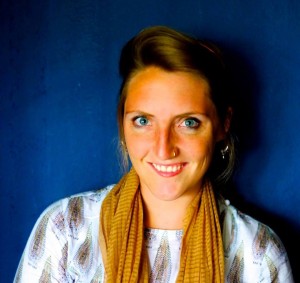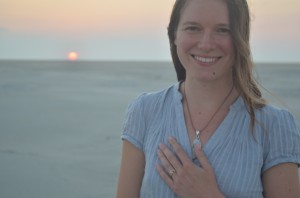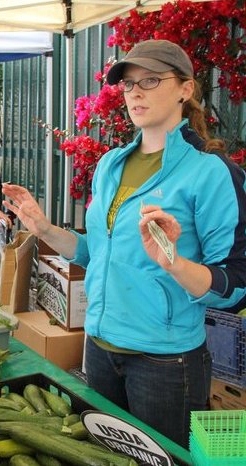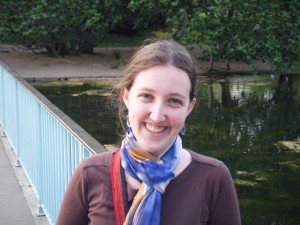Hannah Heinzekehr is a student at Claremont School of Theology, pursuing a Master’s Degree in Community Development and Theology. She works as a Church Relations Associate for Mennonite Mission Network.
Last week, I headed south to San Diego for the Soularize conference: a self-proclaimed “three day ‘learning party’ that will stretch your mind, fill your heart, and encourage you toward the future.” At this mid-point in the semester, a time when much is required of diligent master’s degree students, the idea of taking some time to examine applied theology and to think about the church seemed like a welcome invitation. And when I arrived at Soularize, I found some of these things: I found a comfy, vintage couch at the Claremont School of Theology booth where I got to sit and talk with Dr. Rita Nakashima Brock, I found a challenging message about self-awareness from Dr. Monica Coleman, I found a group of people who are trying to move forward out of traditional evangelical traditions towards a more open and inclusive theology, I heard Dr. John Caputo reclaim the benefits of the word “perhaps,” and I found a beautiful contemplative prayer space to sit and be.
But I also found some things that I did not expect: I found the manifestations of sexism and racism rearing their ugly heads in a place that I had considered “safe.” Now, this probably should not have been a surprise. Sexism, racism and many other systemic “isms” are deeply woven into the fabric of the Christian church, its theology and its people, and even though we’ve begun some of the difficult work of tearing these seams out, there is still a long way to go. But what I didn’t expect was for these “isms” to be played out so publicly.
During the first keynote session, I began to notice a trend: all of the people up on stage thus far had been white and had been men. Using a method taught to me by Christopher Carter, a classmate and friend who is both a pastor and a student of critical race theory, I began to keep track of who was speaking. I drew a chart in the notes I was taking, and would mark down the demographics of each new person who came up on stage. By the end of the day, I was livid. My chart showed that there had been 23 people present on stage. Two of these were women, but only one of them spoke to give a brief announcement. Only one person was not white, and this person did not speak while on stage.
In the days following, there were, in fact, more women and people of color scheduled to speak on stage and to lead seminar experiences. Unfortunately, I was only able to attend the event for the first day and a half, so I didn’t get to experience this expansion of the conversation. I later learned that there had been several circumstances that led to this particular day’s line-up, and that the event planners were also disappointed by this onstage representation. But I still couldn’t help but wonder what it meant that the first whole day of this conference, the day meant to psych attendees up and get them excited for the rest of the week, was run almost entirely by white men. As a female, this silently communicated to me that my place in this movement would be as an outsider.
There is much that goes into getting people up on stage. I know that planning, money, availability, location, and many more factors contribute to who we hear speak at conferences. But, as Christopher pointed out to me, access to many of these resources is also wrapped up in privilege. The people who are tapped to be on a planning committee, the ability to take time off of work, to travel away from the home, and to speak for little or no pay all have roots in each individual’s social locations and available opportunities. And this doesn’t even take into account who’s planning and who they are networking with.
The Emergent Church movement emphasizes an ecclesiology that is fairly flat, and that draws on doctrines of the priesthood of all believers. My home denomination, Mennonite Church USA, has also taken this doctrine seriously. Beginning with the 16th century Radical Reformation, Anabaptists committed themselves to developing a church structure where power was shared equally among all members: men and women (it was, admittedly, a European movement, so most of the early Anabaptists were Swiss-German or Dutch). However, as persecution of Anabaptists ceased, and Anabaptist church structures solidified, the church inadvertently institutionalized racism and sexism right along with their church buildings and pastors. This movement away from equality was not necessarily intentional. Rather, this development illustrates the ways that unjust systems which permeate the culture we live in can make their way into even our “safest” spaces if we are not careful and self-critical.
The Emergent Church and the Soularize Conferences have many good things to offer. They provide spaces for people looking to stretch the boundaries of evangelical theology to gather. They can teach progressive Christians a lot about how to use technology to our advantage, and how to engage popular culture. The Emergent Church has managed to be led by and to capture the imaginations of young adults, and I know that the emphasis on the priesthood of all believers grows out of a spirit of care and an interest in inclusivity. But if adopting this doctrine becomes simply an excuse for the de facto leaders of this movement to abdicate their own power and responsibility for changing the status quo, then I want no part of it.
Perhaps what my own tradition, the Mennonites, and other progressive Christian churches can offer to the Emergent movement is a sense of history and a cautionary tale. We can learn from the mistakes of the past, and we don’t need to repeat them. Today, Mennonites are beginning to realize that even in “flat structures,” power disparity is present. It has and will continue to take effort, intentionality and probably a little bit of grace to really change this and weave a new tapestry of church.
So, I’ve returned from Soularize a little bit wounded and a lot angry. But I also am returning re-inspired, just as I had hoped to be. Re-inspired to continue working towards better inclusivity and equality at Claremont School of Theology. Ready to re-examine the ways that I use my own personal power, and to think about the times when I may have created a “stage” that excluded others and made them feel un-welcome. The conversations happening at Claremont School of Theology and the conversations that began at Soularize are spaces of possibility, and I am excited to re-invest and re-engage.











